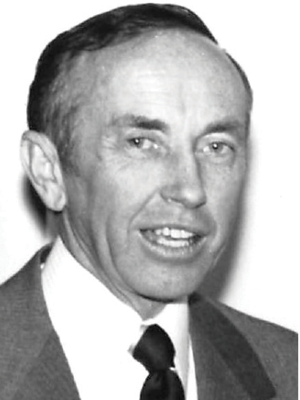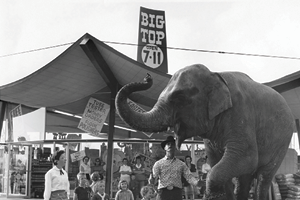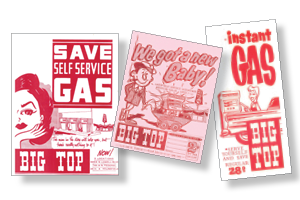Think back to 1994. The film Jurassic Park was all the rage, and a fuel station and c-store that John Roscoe owned in Northern California was hurting for business. Roscoe, who knew a thing or two about publicity, reached deep into his pockets and paid a whopping $200,000 for a 15,000-pound, 75-foot-long, 50-foot-tall dinosaur. It was airlifted by helicopter from Petaluma, California—which cost another $50,000—and placed near the struggling store.
“It stopped a lot of traffic,” said Roscoe.
More importantly, the giant purple dinosaur turned the store’s business around.
Alas, gargantuan reptiles are probably not the answer to the c-store industry’s current set of challenges and opportunities.
Now go back even further to 1964. That’s the year that Roscoe launched self-service fuel at his convenience stores in the Denver area. Roscoe’s advocacy of the idea helped popularize the game-changing innovation. Sixty years after Roscoe introduced that pivotal customer lure, it’s time to ask: what could be the convenience retail industry’s next great innovation?
 Industry icon John Roscoe, now age 94, helped coin the term “convenience store.”
Industry icon John Roscoe, now age 94, helped coin the term “convenience store.”
A Focus on Value
Who better to pose that foundational question to than Roscoe himself?
Roscoe, who is 94, is widely credited with concocting the term “convenience store” in 1957. Four years later, he met with a dozen other c-store owners in Kansas City, Missouri, to co-found NACS. He pushed for the association to embrace the “convenience store” term over other possibilities that included “bantam stores” and “drive-ins.”
According to Roscoe, nobody has that next great industry changing idea at the moment. But all it will take is some out-of-the-box thinking to get there.
“Roscoe was an innovator at a time when a lot of folks were not interested in innovating.”
“You have to find out what people are actually buying today,” Roscoe said.
By that, he means what customers will actually go out of their way for. For many customers, that means value. “Give people more value for their buck,” said Roscoe. Value is key for just about everything in retail, he added.
What most time- and cash-strapped customers today are looking for are tasty, nutritional meals that are value-priced. Typically, Roscoe said, the average family has about 10 favorite meals it eats. C-stores could capitalize by offering a popular meal each day of the week, creating a rotating menu of delicious and budget-priced meals.
Likewise, he said, there are a limited number of key grocery items—including fresh foods—that most folks buy weekly. What if the c-store could also supply these staples, but at a value price instead of at premium price?
 At his Big Top store in California, which had a roof resembling a circus tent, Roscoe once rented a live elephant to draw in customers.
At his Big Top store in California, which had a roof resembling a circus tent, Roscoe once rented a live elephant to draw in customers.
Launching Self-Serve
Real success going forward will require real innovation.
That’s one thing the industry can always use, said Keith Reid, editor of Fuels Market News. He regards Roscoe as one of the best.
“[Roscoe] was an innovator at a time when a lot of folks were not interested in innovating,” Reid said. “He saw the opportunity before other people did—others didn’t see it until they were forced to.”
That can require being open to new ideas—and taking risks.
Roscoe first introduced self-service pumps at one of his c-stores in Westminster, Colorado, on June 10, 1964. A Denver-area inventor had approached him a month earlier about a device he had invented to release gasoline from the cashier’s stand. The device allowed customers to pump their own gas while the clerk inside the c-store was able to control the payment portion of the pumps.
“I was always searching for ways to improve my profits.”
“It sounded bizarre to me, but we had the same banker—and the banker convinced me to do it,” recalled Roscoe.
The first day, Roscoe sold 124 gallons of gasoline.
But Roscoe “never wavers,” said his wife Marilyn, who has been married to Roscoe for 67 years. “He keeps right on his path.”
Roscoe circulated the neighborhood with handbills, and self-serve sales kept rising. He had spent $10,000 on the system—and soon was earning about $50 per day on it. Not a bad return. And self-serve meant Roscoe didn’t need to add any labor.
In 1964, he gave a pep talk about self-serve to an industry convention in Anaheim, California, but he recalled that few folks had the money or interest. It took years to catch on.
By 1969, according to Roscoe, there were just 500 self-serve units in the entire country. Many people thought pumping fuel could be dangerous—particularly for women. Many localities actually had laws against self-service fuel. In Antioch, California, for example, the city required an attendant to sit on a stool and watch customers pump their own gas, which, of course, defeated the very purpose of self-service.
 Skeptics thought it might be dangerous for women to pump their own gas when self-fueling was first introduced.
Skeptics thought it might be dangerous for women to pump their own gas when self-fueling was first introduced.
Creative Ideas
So where is the next John Roscoe? “Who is the next industry person to stand up and say: ‘I have a better idea?’” posed Jeff Lenard, vice president of strategic industry initiatives for NACS. “Who can say that being comfortable isn’t good enough?”
Roscoe’s impact on c-stores was somewhat akin to Walmart founder Sam Walton’s impact on big box retailing, said Lenard. Roscoe was “laser-focused on how to make a profit.”
If it’s not making money, it’s not worth doing, said Roscoe. “I was always searching for ways to improve my profits.”
Roscoe tried just about everything to get folks to stop at his c-stores, especially before self-serve fuel really took off. He tried everything from renting carpet cleaning machines to renting tandem bikes.
Then, there were the so-called “bagatorials.” These were editorials—complete with headlines and strong opinions on everything from taxes to legislation—that one of his c-store brands posted on its grocery bags. Why, after all, allow so much free space to go unfilled?
The quirky concept garnered enough chit-chat that the mini essays were later published in their own book. The back cover to the book asked: “Ever sat down to read a grocery bag?”
But Roscoe’s ideas for drawing in customers and garnering attention grew much bigger than grocery bags. A c-store that Roscoe owned in California was in need of more business, so Roscoe decided to rent a live elephant to attract attention for a few days. At one point, he even considered actually purchasing a live elephant and keeping it outside the store permanently.
Live elephants aren’t part of the future of c-stores, but innovation and evolution are required. “Gasoline is not going to save the c-store business,” said Roscoe. “They will have to continue to innovate and add more value to the consumer.”